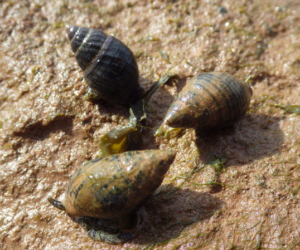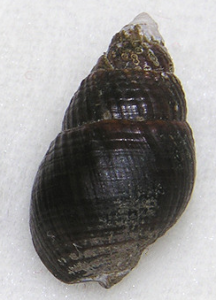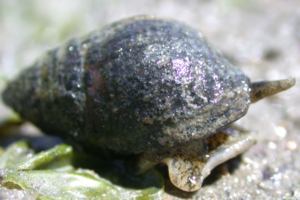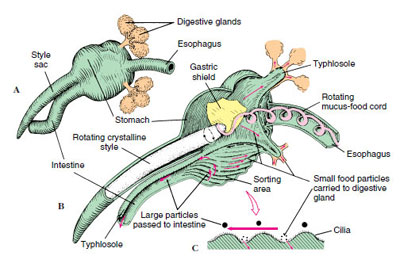
Snails Family gastropodia
Snail Menu
Snails
Snail Anatomy
Mud Dog Whelk (Mud Snail)
Moon Snails
Radula
Slipper Shell
Oyster Drill
Murex Snails

Gastropoda Latin: gaster=stomach podus=foot
Marine Snails
Worldwide, there are over 40,000 recognized species of snails consisting mostly of marine snails of which, several species inhabit Barnegat Bay
Mud Dog Whelk Tritia obsoleta also called Eastern Mud Snail
 The mud dog whelk (also called eastern mud nassa, eastern mud snail, mud basket shell, common mud snail) is about ¾ of an inch in length.
The mud dog whelk (also called eastern mud nassa, eastern mud snail, mud basket shell, common mud snail) is about ¾ of an inch in length.
Mud snails are very common in Barnegat Bay on mud flats, shallow subtidal zones, inlets and lagoons.
They are detritus feeders, eating whatever is found in the film on top of the mud where it lives, including many microscopic marine plants.
They are scavengers and can also be attracted to dead fish or bait in a crab trap.
(Fun) Fact – The eastern mud snail Tritia obsoleta species was previously known as Ilyanassa obsoleta.
 It has a chalky white shell, but is covered by a dark brown to red-brown periostracum. It has 6 whorls and an operculum.
It has a chalky white shell, but is covered by a dark brown to red-brown periostracum. It has 6 whorls and an operculum.
Theses snails form large clusters that tend to be divided into age groups. They are always found in large numbers, sometimes in the hundreds of thousands.
 Mud snails leave a mucous trail as they glide along the bottom.
Mud snails leave a mucous trail as they glide along the bottom.
The mucous is a chemical trail marker. Other snails will find the trail and follow it.
The only time this does not seem to hold true is if one of the snails is sick or injured. The other snails will quickly abandon the unfortunate snail.
photo by Anthony Fisher
Mud snail eggs hatch into larvae after 10 days.
Larvae, immature snails, are free swimming and move with water currents. Larvae feed on phytoplankton 20-30 days before settling down on a substrate (hard surface).
They remain dormant during the winter and do not grow until the summertime. These mud snails live for approximately 5 years.
Snails are univalves, meaning they have one shell (valve) to which they can retract their whole body into when threatened.
They can be algae eaters (algivorous), feed on other animals (carnivorous) or feed on both plants and animals (omnivorous) as predators and scavengers.
Projecting out in front of the snail are two tentacle which are used for sight. Another set are used for touch. Below these tentacle is the mouth.
Credits
Jacksonville Shells
